Olympic Peninsula Traverse: Source to Sea
The rock was so smooth it felt almost soft under the pads of my fingertips, skimming the canyon wall in search of irregularities. Water and time are the most impressive sculptors, capable of shaping solid rock.

The Olympic Peninsula. The terrain was even more raw and rugged than we had anticipated, in a place aptly named after the home of the gods. Ranging from empty sand beaches to lush moss covered rainforest, massive glaciated peaks to turquoise rivers, the peninsula boasts some of the most dramatic and diverse landscapes and ecosystems anywhere on earth. No road crosses through the interior of the peninsula, located only forty miles from the sprawling metropolis of Seattle but a world away. Mt Olympus is positioned in the center of this wild landscape, ringed by rows of peaks which protect it from view from almost every angle.

The crown jewel of the Olympic rivers is the Elwha, made internationally famous by the largest dam removal to ever take place. The Elwha Dam and Glines Canyon Dam had powered the area’s timber industry, while plugging the river and decimating its salmon runs. The reservoirs flooded cultural sites and historic homelands of the Lower Elwha Klallam Tribe, and removed the salmon that are central to their way of life, culture and identity. Long after the power from the dams was no longer necessary, they still blocked the lifeblood of the region’s ecosystem and native culture. I had watched with awe along with river lovers worldwide when in 2014 the 210ft tall Glines Canyon dam came down with the rush of a river set free.
Three years after the last dynamite charges went off, I finally had the chance to experience this inspiring place firsthand. Half the parking lot was covered in a quilt-like mosaic of colorful outdoor gear, rope next to paddles, dehydrated dinners next to ski poles. Joey was holding up each item in turn, judging its weight in his hand like an old woman looking for maximum value in a fruit market. Even the smallest items didn’t escape his scrutiny. Bug spray? No. Headlight? We’ll bring one. Fleece pants? Definitely not. By the end of this little exercise, half of what we had brought was loaded back into the car. The plan was to hitchhike to the Hoh rainforest, summit and ski Mt Olympus, traverse to the headwaters of the Elwha River, then paddle the Elwha from its source to the sea. It took little convincing to be joined by my two friends from Colorado, Joey Schusler and Luke Farny. Both are no strangers to adventure, but what brought us together this time was more than a shared love of outdoor pursuits. We wanted to witness something greater than ourselves, a rare example of humans letting go and allowing nature to take back the reins.
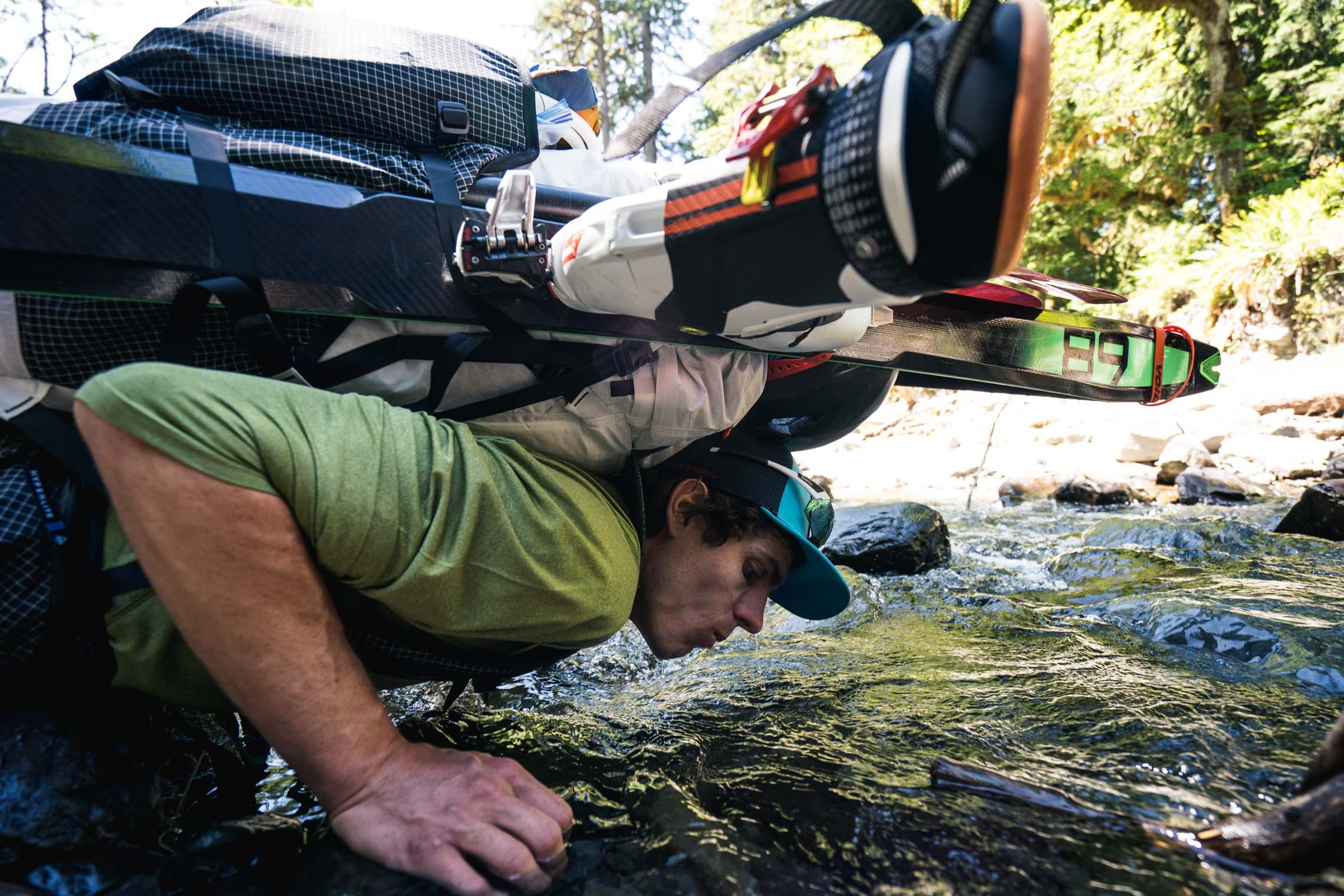

Streams travel through the landscape like veins, and rivers are the arteries that support life on earth. Freshwater laden with sediment, wood, and nutrients circulates through our watersheds. Flood pulses form floodplains and complex channel structures, creating critical habitat and nutrient dense soils. A flourishing riparian zone acts as an organic filtration system, cleansing the water. Aquatic organisms from invertebrates to salmon travel the waterways, in turn feeding mammals, birds, and forests. When this circulatory system is healthy it gives us productive fisheries, land, and clean water. A dam cuts off this flow. Natural fluctuations are replaced with regulated discharges corresponding to times of highest energy use. The downstream ecosystem is deprived of essential sediment and wood, and upstream spawning grounds become devoid of salmon.
Animals dependent on the nutrient-dense fish go hungry. The river delta, crucial habitat to a myriad of species, withers. Acres of land are flooded. There are many examples of watersheds destroyed. What drew us to the Elwha was the chance to see a river healing from a dam-bound existence. After three surprisingly quick hitchhikes, we started up the trail in the early afternoon, praising our luck. Our chosen route was by far the easiest approach to Mt Olympus, but still a twenty mile hike to the base. 12 to 14 feet of rain falls on the Hoh Rain Forest every year, nourishing a lush, green paradise. We wandered along the trail in awe of the majestic forest, weaving between massive old growth trees that were spared from logging by the blessing of inaccessibility. Sagging tree limbs blanketed by thick moss created natural padded hammocks. Cold air lofted off the Hoh river, and a few miles in we took off our shoes and waded to a beach in the middle of the river. We cooked dinner with our feet in the sand, watching the warm evening light bathe the forested valley, the river twisting away into the unknown ahead of us.
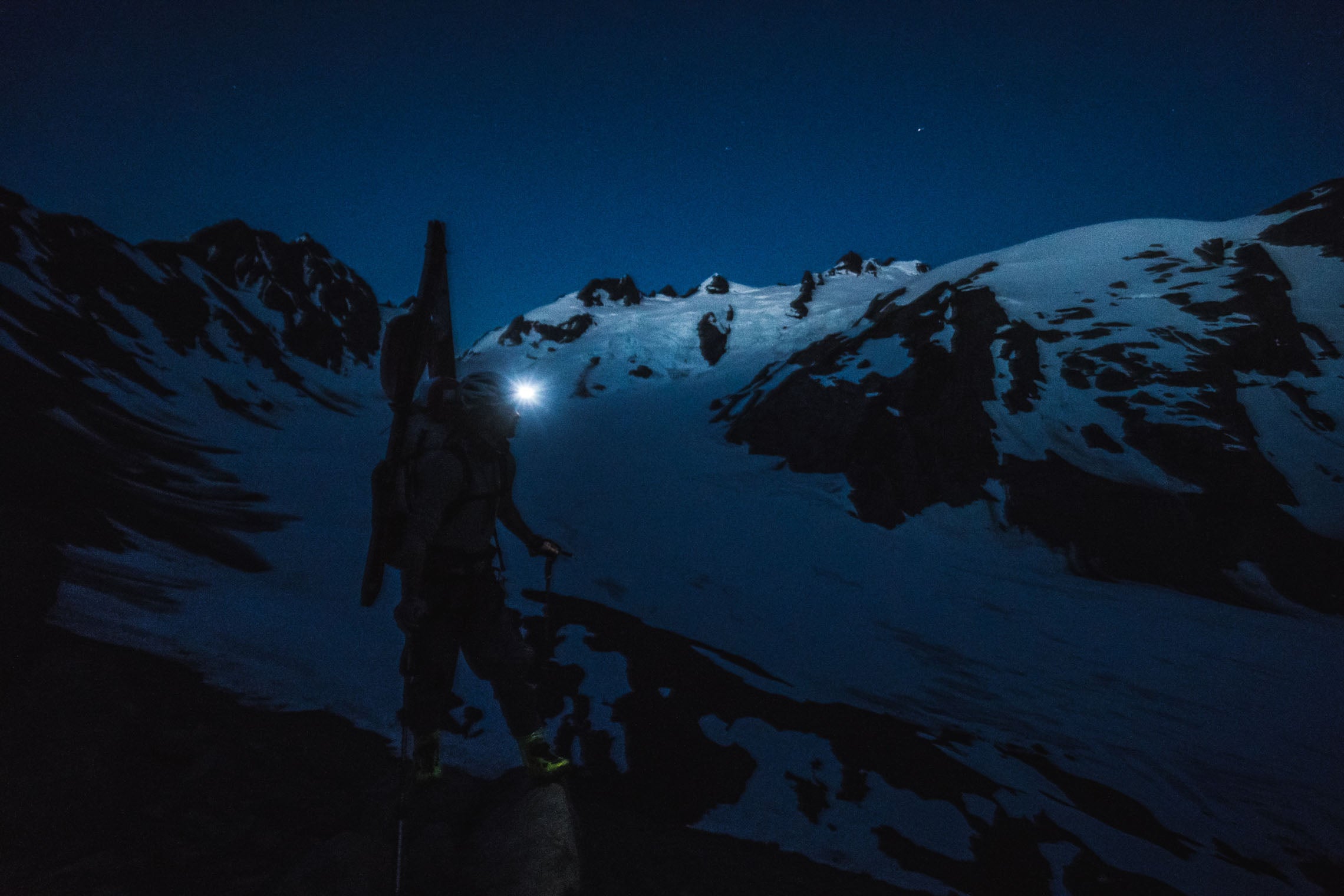
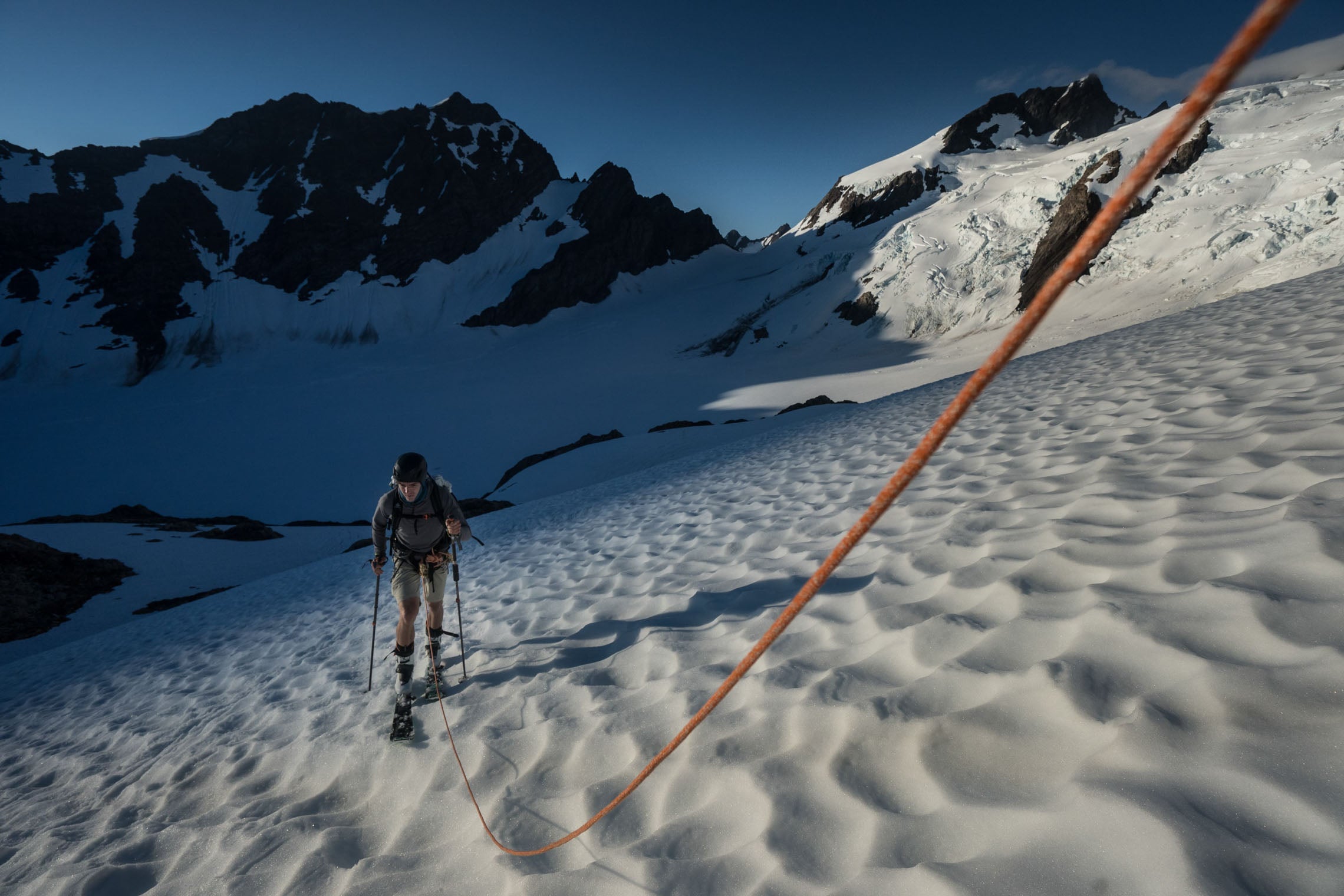

After two days of hauling skis and packrafts on our back with no mountain in sight, questioning the wisdom of our plan, we arose at 2:30 AM to begin our summit day ascent. Three hours later we finally crested a glacial moraine and got our first view of the Olympic massif in the lightening sky. Massive glaciers draped rocky ridge lines, a world apart from the steaming jungle we had been hiking through. Now July, it looked as though winter had never left this place, a thick layer of snow still blanketing the lower glaciers. With giddiness, we transferred our skis and boots from our backs to our feet. Skinning across the glacier approaching the base of Olympus we began to get a sense for the scale of the landscape. Crevasses that looked like small wrinkles from afar revealed themselves as gaping chasms into the abyss. The ski from the summit was a glorious reward of smooth corn harvesting before heading off-route into the unknown.
The next few hours were a backcountry skier’s dream. We ripped over beautiful glaciers, dodged precariously perched seracs, and marveled at the efficiency of our snow sliding sticks in this otherworldy terrain. To top it off we found an untouched meltwater lake that had formed over the ice on the lower glacier, creating the most beautiful blue color we had ever seen. The sun was shining, the stoke level high, so we did the most logical thing we could think of ‚Äì strip to our underwear and pond skim the lake. The next morning we arrived at the birthplace of the Elwha River, a torrent of freezing water gushing out of a snow cave beneath us. Our journey down the Elwha had begun. Paddling a river from its headwaters to its endpoint is appealing as a uniquely natural way of experiencing the landscape, attempting to emulate the path of a rain drop or the melting snow. It is also easily romanticized. We traversed the upper watershed with skis and rafts on our backs, fighting across steep, loose slopes somehow covered in thriving, dense vegetation.


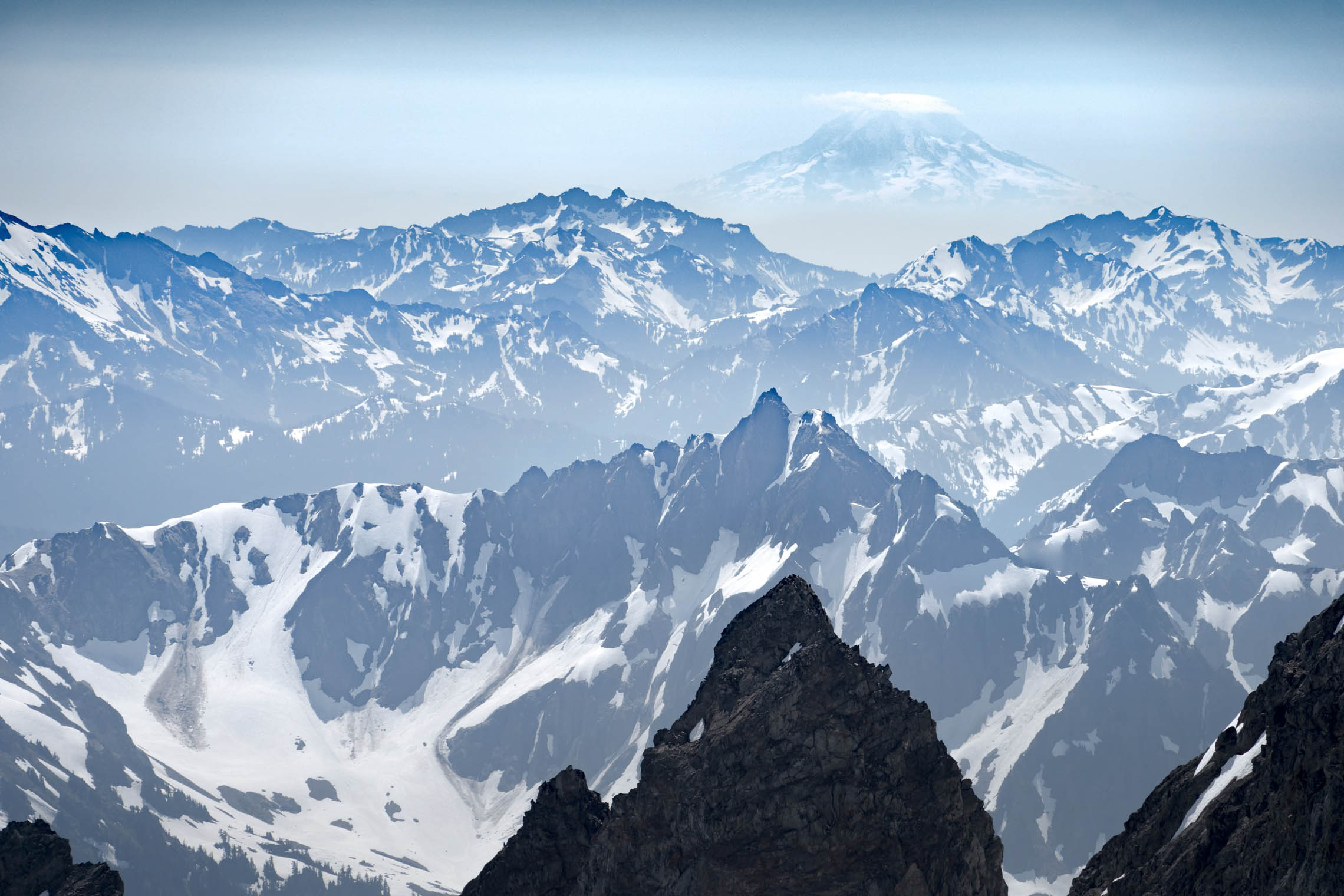
Eventually we rounded a corner and before us lay the packraftable upper Elwha of our dreams. Throwing off our packs, we rejoiced that our loads would now be carried by the buoyant force of water rather than our aching shoulders. The warm sun baked our backs as we inflated the packrafts, drying the sweat from the morning bushwhack. We glided effortlessly onto the crystal clear water and took off downstream in high spirits. A massive logjam came into view as we rounded the very first corner. Eddy out! I yelled, barely stopping in time. Logjam after logjam followed. We somberly trudged alongside the river that we had come so far to paddle. It felt wrong to hike downstream, but we had little choice.
Fortunately, as the Elwha slowly grew with each passing tributary, so did its capacity to move logs. Channel wide log jams became a less common sight and soon enough we decided to test our luck on the river again. As we inflated the packrafts we were careful not to celebrate too early. Soon we were bobbing up and down through the first wave train, three giant yellow ducklings carried off swiftly downstream. Rounding the first bend, we breathed a sigh of relief as no logjam came into view. We came around another corner, then another, and didn’t have to portage once for the rest of the day. Light refracted off the fine glacial silt suspended in the ice cold water, registering in our retinas as an otherworldly turquoise. As the river deepened and the current quickened, pulled into the depths of the gorge away from direct sunlight, the water retained its color but took on a darker hue. We were at the entrance to Rica Canyon, aptly named the Goblin Gates. Dark grey bedrock rose vertically hundreds of feet high, forcing the entire river through its narrow passage.



I dropped in first, then pulled over to scout the first rapid. It was then I realized there was no way we were continuing through the canyon in the packrafts. I signaled to Joey and Luke not to follow, then began scouring the walls for an escape. I found my savior in a crack on the other side of the river. After a sketchy ferry and an even sketchier climb up the wet rock, I came over the rim and happily rejoined my companions. The portage around Rica Canyon brought us to the highlight of the trip, the site of the removal of the Glines Canyon dam.
The river meandered through the loose sediments that had accumulated at the bottom of the reservoir, splitting into braided channels. Years after the removal, the riverbed was still fresh and constantly changing. Where the soil had stabilized, native vegetation was colonizing again, aided by the plantings of countless volunteers. The remains of the giant dam came into view, lending a sense of scale to the monumental removal that had taken place. The center arch portion of the giant concrete structure that had blocked the river channel was removed, but high on the cliffs portions of the dam remained. That night we camped on a beach just upstream of the dam site where boats had once motored two hundred feet above our heads. Fish are now free to swim upstream to seventy miles of pristine spawning habitat, where none could pass for over a century. Indeed, Chinook salmon were observed swimming past this spot just three days after the dam was removed.
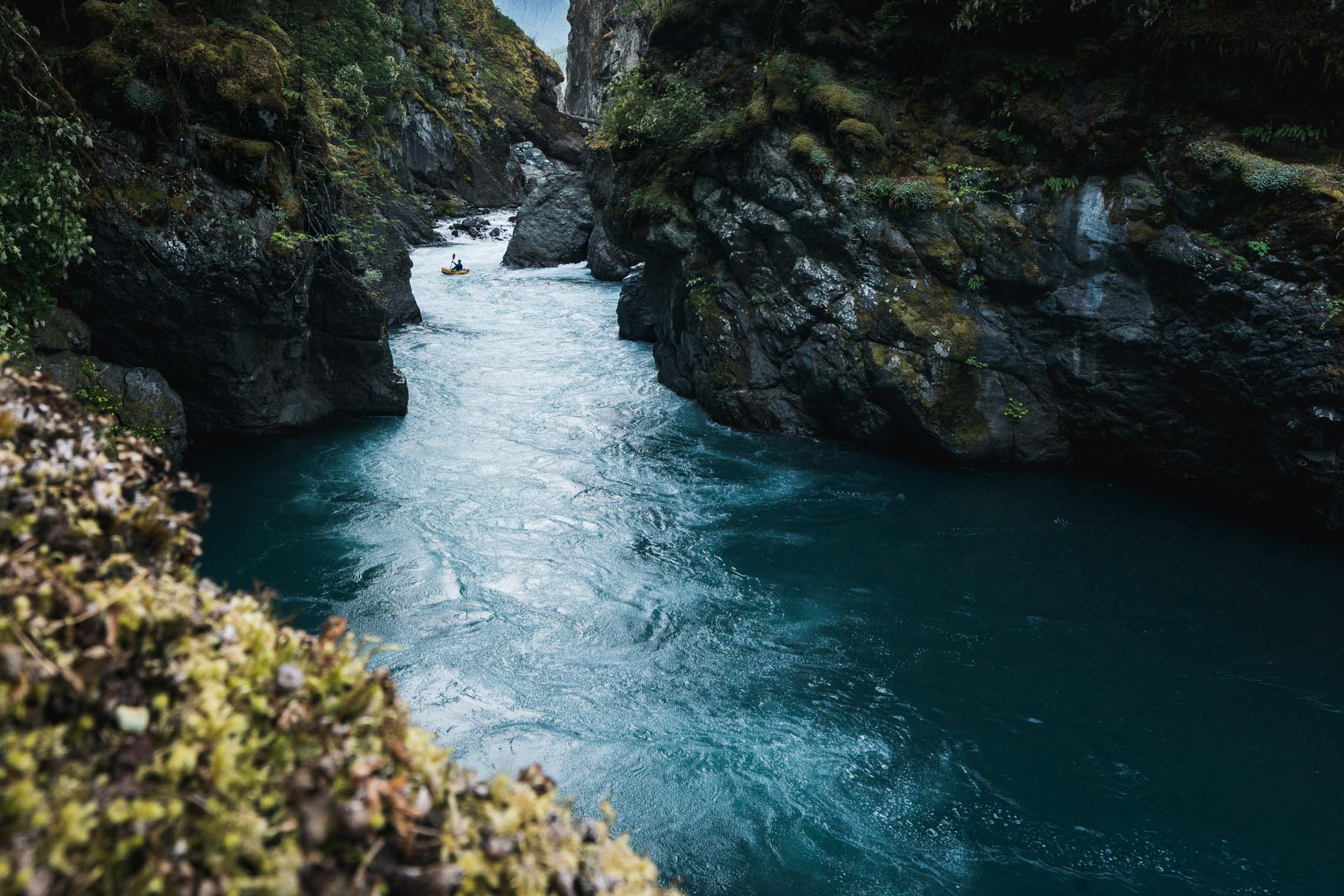

After experiencing the wonders of the Elwha firsthand, it seems incomprehensible that building large dams was ever a good idea. And yet it continues, despite the environmental consequences. But we are now also beginning to learn that as dams in the U.S. age, the economic argument used to justify them makes less sense. Dam planners rarely (if ever) take into account timescales beyond their own lifetimes. At some point, after a dam has outlived its sponsors, dam owners are faced with astronomical costs to maintain them to current safety standards and regulations, and are realizing that a dam’s functional lifetime is far shorter than was planned for, as the reservoirs fill with sediment and the capacity of the dam decreases. This has been and will continue to be a primary factor in large dam removals. The gradient flattened as the river flowed from the mountains toward the coast, the meandering no longer constricted by steep bedrock canyons.
Joey was shivering, following an involuntary ejection into the brain-freeze inducing water earlier that day. We paddled through the old Elwha Dam reservoir, whose height was smaller than Glines but reservoir longer. Massive old-growth stumps dotted the reservoir like gravestones. Perfectly preserved for decades in the deep cold water of the reservoir, they stood as a testament to the Olympic sized forest that had stood here for centuries, cut before the reservoir was first filled. The Elwha continued to carry us out on its free flow to the sea, through the lands of the Lower Elwha Kllallam tribe. Constructed log jams built for fish habitat lined the banks, creating critical channel complexity. We passed two tribe biologists installing a fish counter in the channel to quantify the success of the revitalization of the Elwha. In the northwest, the tribes are the driving force behind most of the river restoration taking place, from high profile dam removals to culvert replacements. The legal mechanism is their tribal treaty rights to a portion of the decimated salmon runs that are central to their entire culture and way of life. However, it may be too little too late to restore any semblance of the historic salmon runs that sustained entire ecosystems and human cultures.



Even in a state like Washington, where the largest dam removal in history took place, a massive new flood safety dam is proposed on the Chehalis River, blocking salmon runs and choking off sediment, nutrients and natural hydrology from the lower river. It has been highlighted as the preferred alternative by the governor, over natural floodplain alternatives. We all need to pay attention to the ancestral people of the lands we inhabit, and listen to their pleas, planning for centuries and future generations rather than letting short term economics define our legacy. Thank you to the people of the Lower Elwha Kllallam Tribe for bringing down the Elwha Dams. The fresh smell of salt was in the air as the river emerged from the trees and we saw the delta extending like a great tongue into the sea.
We floated over freshly deposited sand and gravel, as the Elwha spewed out the nourishing sediment and nutrients that were choked back for over a century. Birds were everywhere, enjoying the spray of the surf. A seal poked its head out of the water, curious what strange new creatures the river was delivering to the ocean. I paddled out into the sea, salt water spraying my face. Past the break, I looked back upstream to see the snowcapped peaks of the Olympics guarding the pristine interior of the peninsula. This is an incredible place in the world, even more so now that the connection from mountains to sea has been restored. As I admired the landscape we had just traveled through, a wave formed over my shoulder and unceremoniously slammed me over. I came up sputtering, just in time to watch a similar fate befall Luke.
Our first obligation upon our return to civilization was to fulfill our duty to the river gods, having each swam the final day. Beer spewed out of my nostrils as I struggled to choke down the Rainier beer pouring out of my old shoe I had worn for the last week in the time-honored tradition of the booty beer (for the uninitiated: when you flip and swim out of your kayak (or packraft), you must chug a beer out of your footwear). I finished just in time to see an elderly couple slowly drive by staring at us, wondering why on earth these three people were chugging out of old shoes in an alleyway of Port Angeles. Luke and I laughed heartily as Joey found a bit more carbonated beverage residing in the heal of his shoe, the beer flowing free as the Elwha down his face.
Recon
from $900
- Perfect for backcountry whitewater adventures
- Whitewater Series
- Spraydeck
- Weight: 9 lbs 5oz (4.2 kg)
